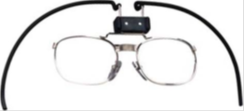 By Brent Jones, Spectacle Kits Sales, SafeVision, LLC
By Brent Jones, Spectacle Kits Sales, SafeVision, LLC
“Primum non nocere,” do no harm, is the primary element of the Hippocratic Oath which physicians take as they enter practice. This is their oath to preserve the wellbeing and safety of their patients. Safety managers have a similar responsibility, to do their upmost to protect the health and safety of their co-employees. The responsibility may be overlooked, though no fault of the safety manager, when ordering spectacle kit inserts for their employees that use full face respirators.
To do no harm as a safety manager would be a given, but it is not always as easy as that. Spectacle kits can be an easy item for a manager to let their employees order, have lenses put in the spectacle kits and then use them. But doing no harm it is not as simple as that, much more goes into the safety of eyes then just any lenses when ordering spectacle kits.
In 1976 ANSI and OSHA established a joint coordinating committee that introduced many changes to the eye care industry. The alignment of these two entities, one federal and one private, marked the onset of the new era of compliance across the board in every facet of safety, including specific guidelines for spectacle kits.
With the rapid changes in technology and materials, it is becoming difficult for local retail eyecare providers to remain current and compliant. Safety managers are fully versed in OSHA, but the additional regulations and ANSI standards in lenses make the optics of spectacle kits more difficult than ever before. Unbeknown to safety managers, there are potential problems in regards to visual acuity in spectacle kits while keeping within the ANSI/OSHA standards. These problems pertain to; Vertex Distance, bifocals/progressive and ANSI markings on lenses.
Vertex distance is the distance from the back surface of the corrected lens inside the spectacle kit to the front of the cornea. Vertex distance is important on how well users can see; especially for users with presbyopia (farsightedness, not being able to see things near). In spectacle kits, Vertex distance can make presbyopia employees with higher prescriptions incur more distortion and take longer for their sight to adjust if not properly fitted.
Multi focus lenses are most commonly known as either lined bifocals (ST 28 or ST 35 depending on the length in millimeters of the bifocal across the lenses) or as a progressive (no lined bifocal which is technically three fields of vision). Lined bifocals are typically measured to a certain point on the on an employee’s face in relation to where the spectacle kit sits inside the respirator mask. Spectacle kits inside self-contained breathing apparatus (SCBA), do not sit where normal eyewear sits on the users face. With the distance of the spectacle kit being farther away, adjustments must be made for the best visual acuity. The ability to adjust for progressive lenses is limited and therefore optical experts in safety eyewear recommend that progressive lenses not be used in spectacle kits.
It is common knowledge for personnel that works with safety eyewear, that they must have the ANSI markings and information about the manufacture of the lens noted on the lens. Few if any retail eyewear companies or local optical providers can put lenses into a spectacle kits. Those that can usually do not know the lenses required in spectacle kits must not only follow safety eyewear standards, in addition they are not aware of specific restrictions on multi-focus lenses.
Safety managers should be aware of the complexity surrounding of what would seem to be a simple task, ordering lenses for spectacle kits. For safety managers ordering spectacle kits, do no harm is an achievable goal.
© SafeVision, LLC
www.safevision.net


